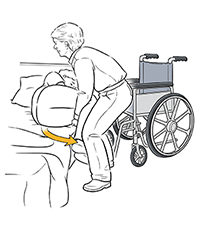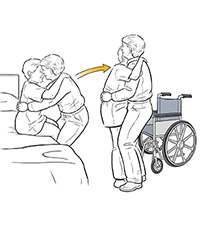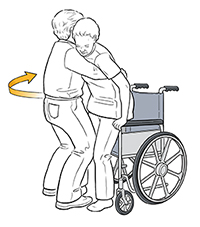When someone is dependent on a wheelchair, it is important to know how to help them safely get in and out of it. This will help them to be mobile ng while reducing their risk of injury. For safety’s sake, learn how to help them in and out of the wheelchair. One basic method is shown here.
Step 1. Sit the person up:
-
Help the person put on proper footwear before they stand.
-
Lock the wheelchair.
-
In case of 1-sided weakness, place the wheelchair near the person's stronger side.
-
Help the person turn over onto their side, facing you.
-
Put an arm under their upper back with your hand supporting their shoulder. Put your other hand behind their knees.
-
Swing their legs over the edge of the bed, helping them to sit up.
-
If needed, attach a transfer belt around the person's waist.
Step 2. Stand the person up:
-
Have the person scoot to the edge of the bed.
-
Position your legs on the outsides of the person’s legs.
-
Put your arms around their chest and clasp your hands behind their back. Do not let them grab or hold you around your neck. Use a transfer belt if needed.
-
Help the person shift weight in a rocking motion until they reach a standing position.
Step 3. Sit the person in the wheelchair:
-
Once standing, have the person pivot toward the wheelchair, as you continue to hold on. Always transfer toward the person’s stronger side.
-
Have the person take a few steps back until they can feel the wheelchair on the back of their legs.
-
Ask the person to grasp the arm of the wheelchair and lean forward slightly.
-
As the person bends toward you, bend your knees and lower the person into the back of the wheelchair.
-
Be sure that they are sitting comfortably in the wheelchair.
Important safety tips
Lifting a person can be hard on your back. To reduce the risk of a back injury, remember to do the following:
-
Organize the steps in your head before you start.
-
Explain the steps of the move and ask the person to tell you when they are ready to transfer.
-
Keep your knees bent and your back straight.
-
Use a transfer belt to provide a firm hold, rather than clasping your hands behind the person's back.
-
Get help when you need it.
-
Ask to practice with supervision.




